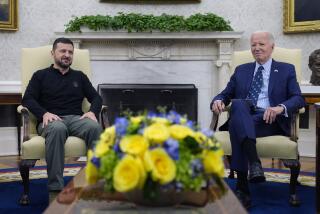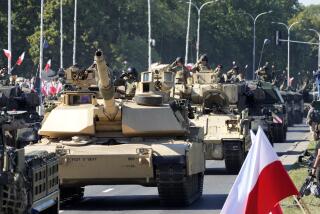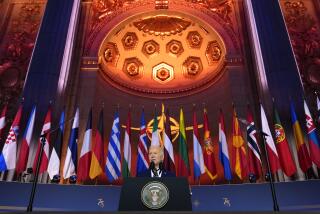Defense Outlays Give NATO Needed Muscle : Major Non-Nuclear Gains Seen as Making Units Better Able to Deter or Repel East Bloc Forces
KOBLENZ, West Germany â With an impressive display of firepower, the tanks, field guns and support vehicles of the West German armyâs 34th Panzer Brigade lumbered through the hilly training area just east of the Rhine.
It was a new generation of hardware and, officers noted proudly, the soldiers manning it were better trained than at any time in memory.
âAt present weâre damned good,â stated the unitâs commander, Col. Gero Koch.
In the city of Wurzburg, 100 miles farther east, an officer of the U.S. Armyâs 3rd Infantry Division spoke with equal confidence.
âTen years ago, about a third of my platoon had high school diplomas,â said Capt. David Tippet, now his unitâs public affairs officer. âBut in my section today, everyone is a graduate, and some have gone to college. Our soldiers are smarter, our equipment is newer and our preparedness is higher.â
Buoyed by sharply increased defense spending over the last decade, the North Atlantic Treaty Organizationâs non-nuclear forces stationed in Europe have dramatically improved in recent years, military analysts agree.
Yet there are also serious problems looming for the alliance that could significantly affect preparedness in the future. By far the most worrisome of these is financial.
Whether the improvements of the past are enough to compensate for the numerically superior Soviet Bloc forces deployed along Europeâs East-West divide is expected to dominate the U.S. Senate debate on ratifying the U.S.-Soviet Intermediate-range Nuclear Forces treaty.
The treaty, signed last month in Washington by President Reagan and Soviet leader Mikhail S. Gorbachev, would remove an entire class of nuclear missiles from Europe: ground-launched weapons with ranges of 300 to 3,000 miles.
Senate opponents of the treaty question whether removing all 1,800 of the American and Soviet intermediate-range nuclear warheads could irreparably compromise the Westâs nuclear âequalizer,â make nonsense of alliance strategy and leave its defenses dangerously exposed to Moscowâs acknowledged larger conventional forces.
The Senate debate unfolds against a backdrop of U.S.-Soviet negotiations in Geneva to cut long-range nuclear arsenals by up to 50%. It also comes after a gradual reduction over the last two decades of allied short-range, tactical nuclear weapons stockpiled in Europe from about 7,000 to 4,000.
Despite these developments, planners at NATOâs sprawling headquarters in Brussels maintain that even with a 50% cut in strategic arsenals, the West would retain a credible nuclear threat of about 6,000 warheads to back up its conventional defenses.
Forces Called Strong
Further, Western military analysts believe that NATOâs conventional forces today are strong enough on their own to block any quick Soviet thrust through Western Europe, and, perhaps more importantly, present a powerful enough image to deter the Soviets from contemplating such an attack.
âThe conventional structure is presently enough to persuade Moscow that an attack would bring costs far beyond any perceived political gains,â noted a senior NATO planner.
A Pentagon study prepared by the Joint Chiefs of Staff for then-Secretary of Defense Caspar W. Weinberger last year assessed such intangibles as leadership, morale and training quality in addition to numerical strength, and is reported to have reached a similar conclusion.
âThose who see the Soviets crashing through in 48 hours are giving them the benefit of every doubt and thatâs just not credible,â maintained a senior NATO official. As is customary at NATO, the official declined to be identified by name or nationality.
Still, defense analysts believe that the sheer weight of numbers possessed by the Soviet-dominated Warsaw Pact, coupled with its shorter supply lines in time of conflict, tip the overall conventional balance in Moscowâs favor.
According to the publication Military Balance, issued last fall by the London-based International Institute for Strategic Studies, the Warsaw Pactâs numerical advantage is substantial in many areas: 2.4 to 1 in main battle tanks, 3 to 1 in artillery and 2 to 1 in combat aircraft, although roughly equal in total mobilized manpower.
âIf you eliminated nuclear weapons today, then the Soviets would have an edge,â noted Francois Heisbourg, director of the respected institute. âYou can quibble about the extent of that edge, but itâs there.â
Deterrents Interlinked
NATO strategists tend to agree with this assessment, but they note that under present strategy, the allianceâs conventional and nuclear deterrents are tightly interlinked.
Also, those who monitor the East-West military balance believe that the upgrading of NATO forces over the last decade has narrowed the differences in conventional arms strength significantly.
Among the major changes:
-- Armed forces in the major alliance countries, including the United States, Britain and West Germany, have modernized their equipment, brought their units up to full strength and intensified training in recent years.
The U.S. 3rd Infantry Division, for example, has received new model tanks, helicopters, armored personnel carriers and field guns in the last four years. This month, soldiers were being equipped with new M-16 A-2 rifles. The situation was similar at the West German armyâs 34th Panzer Brigade.
In Britain last week, the government announced plans to re-equip an entire 5,000-man army brigade as a special helicopter-borne, fast-reaction force to counter any surprise thrust by Soviet armor across the North German plain.
âItâs a weakness that we saw and have rectified,â explained a spokesman at Britainâs Ministry of Defense.
-- Long-neglected ammunition stocks in Europe have been gradually increased from a low of just 12 daysâ supply in the early 1980s to an anticipated 21 days by 1990, a development that will help ease an acknowledged NATO weakness: the ability to sustain effective combat operations beyond any initial outbreak of hostilities.
-- During the 1985-1990 period, alliance spending on other unexciting, yet vital, support facilities such as supply centers, fuel depots and aircraft shelters for planes arriving from the United States as emergency reinforcements is expected to reach $10 billion. The figure is more than double that of the first half of the 1980s.
-- Under a 1985 accord, NATO nations are pooling expertise and resources to produce high-technology weapons systems that no single country could afford. In addition to cheaper high quality weapons, this development is expected to improve hardware compatibility and ease logistics headaches within the alliance.
Eight alliance countries, including the United States, for example, are involved in the development of a standard frigate for NATO navies in the 1990s.
-- Immeasurables, such as communications, planning and logistics cooperation have also been improved, according to NATO officials.
The American ambassador to Britain, Charles H. Price II, summed up, âToday, the alliance has reached a level of preparedness not seen in years.â
Problems Loom
Yet the future looks far from rosy. Commitments by the United States and its major alliance partners throughout much of the last decade to boost defense spending by around 3% annually have now begun to fade.
The United States, which averaged increases of about 6% in overall defense outlays during the early years of the Reagan Administration, slumped to a growth of 1.7% last year. This year, U.S. defense spending is expected to decline 3.1% from last yearâs level.
With fiscal pressures mounting and the declining dollar inflating the cost of overseas commitments, military analysts predict that a diminished American military presence is inevitable.
Costs Prohibitive
âThere is no way the United States can preserve its force presence in Europe 100% with those (defense expenditures) figures,â said Heisbourg of the strategic studies institute.
Although less dramatic, the picture is similar in other large NATO countries.
Britain, for example, which increased its defense budget steadily through much of the 1980s, now forecasts a 5% decline in military spending over the last three years of the decade.
In Denmark, military spending is so contentious that the government there has failed to agree on the size of a 1988-92 defense budget despite more than a year of wrangling.
Squeeze Is On
âThe squeeze is across the board,â one NATO official commented. âI donât think anyone is going to make the 3% target in the year ahead.â
Citing financial constraints, Belgium has confirmed that it plans to withdraw its air defense commitment for NATOâs vital central front, while Canada, after a review of its own national priorities, has announced its intention to withdraw its commitment to reinforce NATOâs northern flank in Norway in the event of attack.
Both decisions have had a psychological as well as a military impact on alliance members, according to NATO staff members.
In West Germany, the problem is more fundamental: the worldâs second-lowest birth rate during much of the last two decades has resulted in a 50% decline in West Germanyâs projected manpower pool for the period 1986-1994, an ominous development in the nation that maintains the largest number of NATO forces in Europe.
Few believe that the proposed West German remedy to extend active duty time for conscripts from 15 to 18 months and to eliminate limited draft exemptions will be enough to maintain current strengths.
âI question whether they will be sufficient,â one NATO planner commented.
Women May Be Drafted
Panzer brigade commander Koch agreed, predicting that the government will most likely have to boost spending to attract more volunteers, or begin drafting women for the first time.
The financial constraints on NATO have helped accelerate efforts for greater defense cooperation--so-called smarter planning rather than more spending--but the costs of maintaining modern conventional defenses will remain extremely high.
The Warsaw Pact nations also face difficulties, one military specialist said, as demographic trends in the Soviet Union force the nation to draw a greater number of its recruits from the more remote Asian republics, where levels of education and exposure to technology are far lower than they are in the East European republics.
Aging Hardware
The Warsaw Pactâs superior armored strength is composed in part of aging hardware, some of it five generations old. Much of it will prove costly to replace and create a potential logistical nightmare to keep in place.
Gorbachevâs domestic reforms could also siphon off talent that had drifted into the armed forces because of the absence of opportunity elsewhere.
Heisbourg notes that during the initial years of Nikita S. Khrushchevâs reforms in the 1950s, an estimated 1 million Soviets left the armed services and defense spending was reduced as the new leader tried to divert talented manpower into the civilian economy.
But with efforts now under way in Vienna to develop a framework for agreeing to conventional arms reduction talks in Europe, both alliances would seem reluctant to weaken potential negotiating positions by embarking on unilateral cuts.
With NATOâs conventional forces generally agreed to have a qualitative, if not numerical, edge over those of the Warsaw Pact, military analysts believe that any agreements for mutual cutbacks in conventional forces in Europe would probably be advantageous to the West.
As a respected NATO planner said, âWithin most reasonable political and military criteria, it could only improve our situation.â
More to Read
Sign up for Essential California
The most important California stories and recommendations in your inbox every morning.
You may occasionally receive promotional content from the Los Angeles Times.










